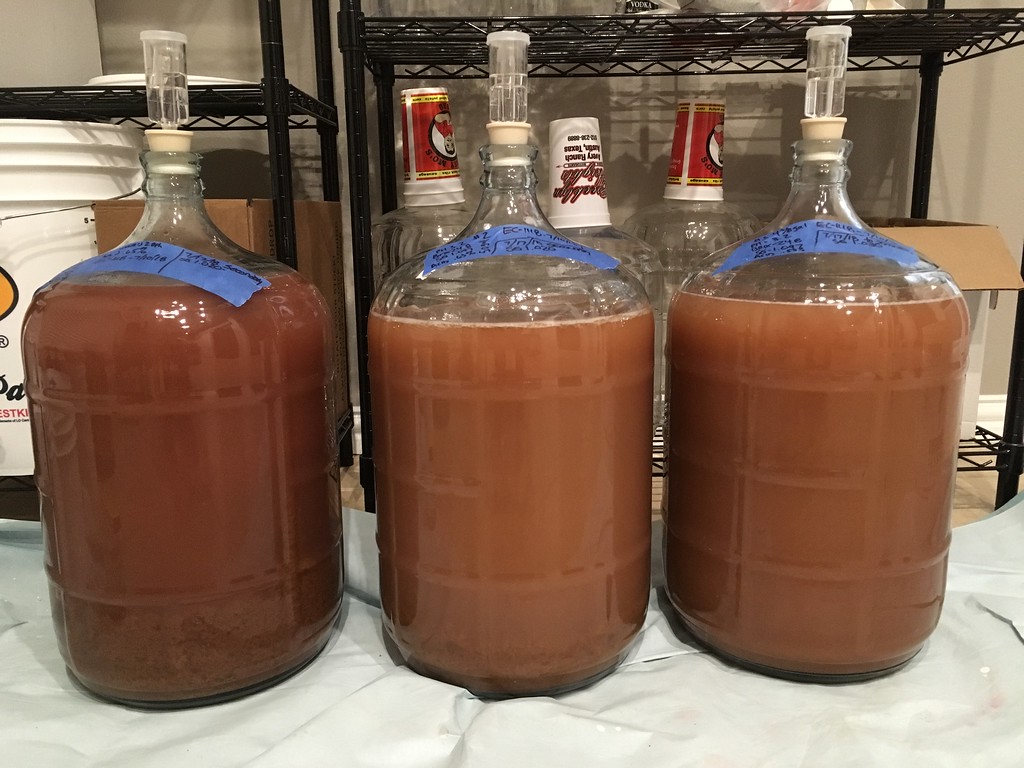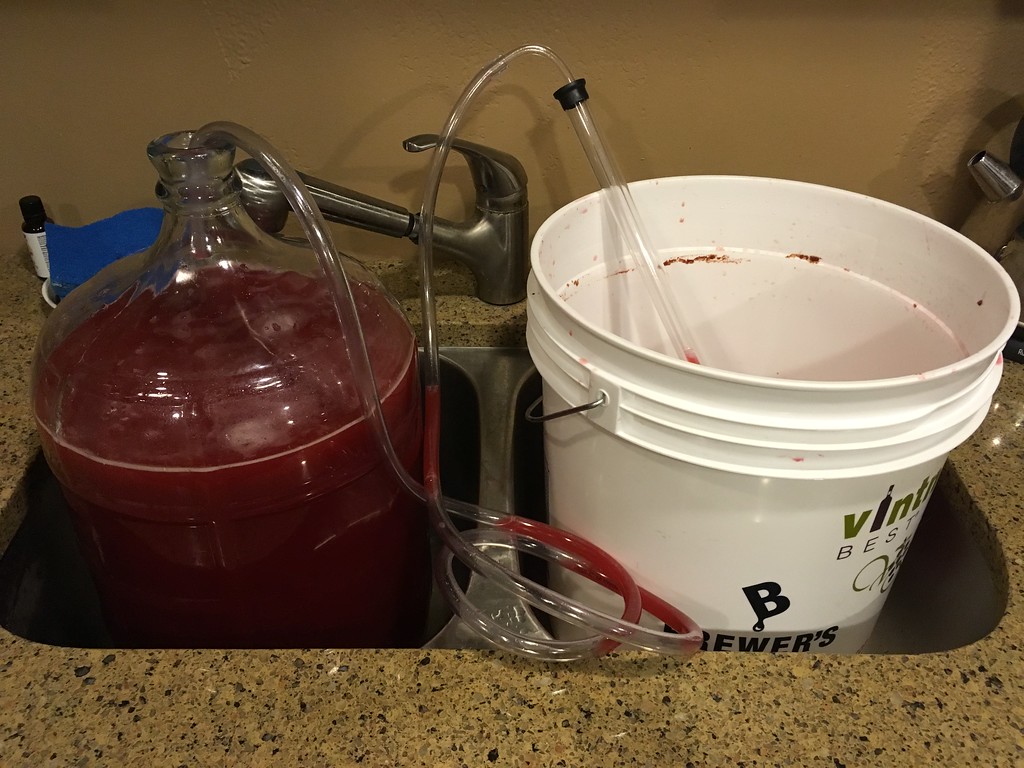Ok. Do I toss the sample or pour it back in? I'll do that with tonights measurements.
If you sanitize everything that touches the wine, dump it back in.

Ok. Do I toss the sample or pour it back in? I'll do that with tonights measurements.
Alrighty, things are progressing John! Today was such a long day there's no way I can rack off #1 and #2 tonight as not being quite ready so they'll have to wait until tomorrow evening and probably be a little past 1.030. Which brings me to my next set of questions....
1) I'll clean/sanitize my siphon/tube, 5gal carboys, bungs and airlocks. Then I siphon from my plastic tub primary to my secondary carboy, right? I'll grab the SG and pH at that time. What do I do if the carboy doesn't fill to the top leaving headspace? Can I add something like a welches grape juice? I have no comparable wines (but I could get something at Specs if needed) I'll affix the airlock, fill it with vodka and smile, right?
2) Do I add anything at this point? I'm thinking when it transfers at 1.030 to the secondary it just sits there, percolates and I monitor it again daily for SG.
3) When we get to 1.000 or .995, then I kill the fermentation with something, right?
Looking down the road, I have on my shelf Gelatine Finnings, Sparkolloid Powder, Wine Tannin, Acid Blend and a bag of Bentonite to mix in 5gal of product. Should I get more/different stuff in the next few days?
This is exciting! And THANK YOU......
6 days post pitch--->
Bucket #1
Volume: 5.0 gallons
pH: 3.5 / 3.4 / 3.3 / 3.2 / 3.2 / 3.3 / Not measured
SG: 1.095 / 1.094 / 1.095 / 1.090 / 1.060 / 1.050 / 1.035
Bucket #2
Volume: 5.0 gallons
pH: 3.2 / 3.0 / 3.0 / 3.0 / 2.9 / 3.1 / Not measured
SG: 1.095 / 1.095 / 1.095 / 1.090 / 1.070 / 1.052 / 1.035
Bucket #3
Volume: 4-5/8 gallons
pH: 3.2 / 3.2 / 2.9 / 2.9 / 2.9 / 3.0 / Not measured
SG: 1.097 / 1.095 / 1.094 / 1.090 / 1.070 / 1.055 / 1.045
Yes on the sanitizing, be clean as possible. Fill your carboys above the shoulder, but not into the neck, and don’t transfer until you’re below 1.010, wait til 1.000 if you can. No need to top up at this point, CO2 is still protecting. Headspace is ok right now.
When you rack again later, after fermentation, be prepared to top up with an inexpensive wine, you should be able to find some rose’ to work just fine.
You don’t kill fermentation, it stops on its own when the sugar is all gone, SG below .998 and unchanged for three consecutive days.
You have enough chems for fining if you choose that route, pectic enzyme may be needed, but you’ve got time.
For now, stay the course and plan to rack / transfer near 1.000.
John said it perfectly.












I suppose the color really boils down to the use of the must bag vs not using it?
I have to admit, this is fun just watching the three glass carboys 'boil&roll' all on their own. With the glass, you can easily see all these little lava flows rising then sinking only to repeat themselves time and time again while the airlock just keeps burping away. I know - I'm easily amused....
On a serious note, my understanding is the fermentation will cease around the .995 mark. Do I have to do anything at this time other than just watch it and then measure SG when it appears to be slowing down considerably? Not sure I want to rack it with this much activity going on. And there must be 1/2 gallon of yeast/lees in the bottom of a couple and close to a gallon in another while still boiling/rolling. I also understand as long as it bubbles, I've got a layer of protection on top, so I'll need some direction in that racking/off-gassing part when we get there.
Well crap. Now that I re-read your instructions above about moving from primary to secondary at 1.000 I feel pretty stupid. Please don't hate me for not following your guidance. I just had a brain hiccup and wasn't thinking and it certainly wasn't intentionally disobedient.
Update time and process questions!
So if I understand correctly, all the sugar should now be consumed and converted to alcohol at this point. This was day one reading of the SG at the 'done' mark, so I need to do this two more days and see if it changes, right? If it doesn't change any, then I go ahead and rack off the 'good stuff' into a clean sterilized carboy leaving the gross lees behind for the compost pile. When racked off to that clean secondary, that's also when I add potassium metabisulphite at the rate of 1/4 tsp / 6 gallons (to protect the new product against nasties), and TOP UP with the rose I bought and airlock it. I can then lit it sit for three months to settle and then check in on this batch, right?
OR.......
Is the manual degassing a 'best practices' thing and should I do it? And should I add clearing agents of any type and if so, when?
Right now I tried it and there's little doubt I made (well, the yeast made) alcohol. If my calculations are correct, this comes in about 13.75% ABV and it definitely has an alcohol smell and taste to it as well as a somewhat carbonated feel across the tongue. It's not really that great at the moment either so I'll need some guidance in that department when the appropriate time comes.
12 days post pitch--->
Bucket #1
Volume: 5.0 gallons
SG: 1.095 / 1.094 / 1.095 / 1.090 / 1.060 / 1.050 / 1.035 / .990
Bucket #2
Volume: 5.0 gallons
SG: 1.095 / 1.095 / 1.095 / 1.090 / 1.070 / 1.052 / 1.035 / .990
Bucket #3
Volume: 4-5/8 gallons
SG: 1.097 / 1.095 / 1.094 / 1.090 / 1.070 / 1.055 / 1.045 / 1.000
You are correct with your process, though bucket 3 may still need some time to complete. If you intend to age your wine in bulk (that would be my suggestion) then you do not need to degas, time will allow the gas to dissipate, and will also allow the flavors to develop.
Thank you, John.
So "bulk" aging is clearing it in the carboy and letting it age there, right? The other is "bottle aging" where you degas, bottle and then let it age?
@M38A1 said: “Then I suppose we get to talk about what happens in those next three months, right? I'm guessing keep an eye on the airlock fluid level for sure.”
Yep, keep an eye on it, should be fine, but check it, and that’s it.
Now’s when it gets fun, the bug has bitten, you’ve gained understanding of the process, and you’ll probably start looking to ferment anything that can’t run away. Fall grape season is around the corner, find some grape growers in your area or a distributor, try your hand at fruit, whatever you can to keep from messing with the completed batches.
Enter your email address to join: